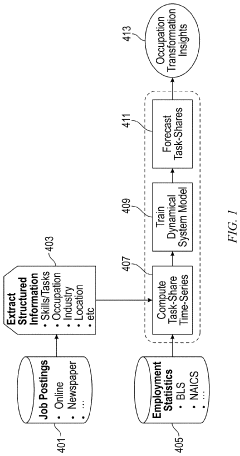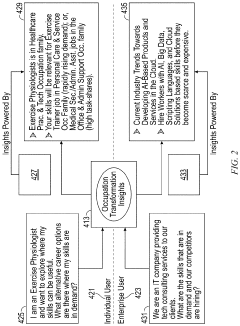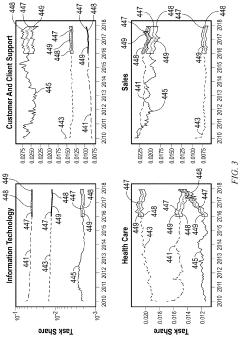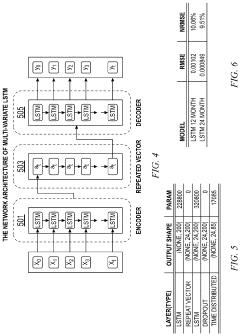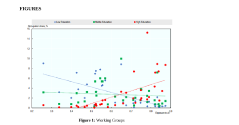AI and the Future of Work: Predicting Job Market Transformations in the Age of Artificial Intelligence
MAY 12, 20259 MIN READ
Generate Your Research Report Instantly with AI Agent
Patsnap Eureka helps you evaluate technical feasibility & market potential.
AI Impact on Work: Background and Objectives
Artificial Intelligence (AI) has emerged as a transformative force in the global economy, reshaping industries and redefining the nature of work. The rapid advancement of AI technologies, including machine learning, natural language processing, and robotics, has sparked intense debate about the future of employment and the evolving relationship between humans and machines in the workplace. This technological revolution is not merely a continuation of past industrial shifts but represents a fundamental change in how work is conceived, performed, and valued.
The primary objective of this technical research report is to explore the profound impact of AI on the job market and to predict the transformations that will occur in the coming decades. We aim to provide a comprehensive analysis of how AI is altering existing job roles, creating new opportunities, and potentially displacing certain types of work. By examining current trends and projecting future developments, we seek to offer insights that can guide policymakers, business leaders, and individuals in preparing for the AI-driven workplace of tomorrow.
The evolution of AI in the workplace has its roots in early automation efforts but has accelerated dramatically in recent years due to increased computing power, big data availability, and algorithmic advancements. From factory floors to corporate offices, AI is being integrated into various sectors, automating routine tasks, enhancing decision-making processes, and enabling new forms of human-machine collaboration. This integration is not uniform across industries or regions, creating a complex landscape of adoption and impact.
As we delve into this topic, it is crucial to consider the broader societal implications of AI-driven job market changes. These include potential shifts in income distribution, the need for reskilling and lifelong learning, and the ethical considerations surrounding AI deployment in the workplace. We will explore how different demographic groups may be affected and what strategies can be employed to ensure an equitable transition to an AI-augmented workforce.
Furthermore, this report will investigate the timeline of AI integration in various industries, identifying key milestones and projecting future developments. By analyzing case studies and expert opinions, we aim to provide a nuanced understanding of how AI is likely to transform specific job categories and create entirely new roles that do not yet exist.
Ultimately, our goal is to present a balanced view of the opportunities and challenges presented by AI in the workplace, offering actionable insights for stakeholders across the public and private sectors. This research will serve as a foundation for developing strategies to harness the potential of AI while mitigating its disruptive effects on the labor market and society at large.
The primary objective of this technical research report is to explore the profound impact of AI on the job market and to predict the transformations that will occur in the coming decades. We aim to provide a comprehensive analysis of how AI is altering existing job roles, creating new opportunities, and potentially displacing certain types of work. By examining current trends and projecting future developments, we seek to offer insights that can guide policymakers, business leaders, and individuals in preparing for the AI-driven workplace of tomorrow.
The evolution of AI in the workplace has its roots in early automation efforts but has accelerated dramatically in recent years due to increased computing power, big data availability, and algorithmic advancements. From factory floors to corporate offices, AI is being integrated into various sectors, automating routine tasks, enhancing decision-making processes, and enabling new forms of human-machine collaboration. This integration is not uniform across industries or regions, creating a complex landscape of adoption and impact.
As we delve into this topic, it is crucial to consider the broader societal implications of AI-driven job market changes. These include potential shifts in income distribution, the need for reskilling and lifelong learning, and the ethical considerations surrounding AI deployment in the workplace. We will explore how different demographic groups may be affected and what strategies can be employed to ensure an equitable transition to an AI-augmented workforce.
Furthermore, this report will investigate the timeline of AI integration in various industries, identifying key milestones and projecting future developments. By analyzing case studies and expert opinions, we aim to provide a nuanced understanding of how AI is likely to transform specific job categories and create entirely new roles that do not yet exist.
Ultimately, our goal is to present a balanced view of the opportunities and challenges presented by AI in the workplace, offering actionable insights for stakeholders across the public and private sectors. This research will serve as a foundation for developing strategies to harness the potential of AI while mitigating its disruptive effects on the labor market and society at large.
Labor Market Demand Analysis in AI Era
As artificial intelligence continues to advance at an unprecedented pace, its impact on the job market is becoming increasingly significant. The demand for AI-related skills and expertise is rapidly growing across various industries, reshaping the labor market landscape. This analysis aims to provide insights into the evolving job market dynamics in the AI era, focusing on emerging trends, skill requirements, and potential shifts in employment patterns.
The adoption of AI technologies is creating new job categories and transforming existing roles across sectors. Industries such as healthcare, finance, manufacturing, and retail are experiencing a surge in demand for AI specialists, data scientists, and machine learning engineers. According to recent market research, the global AI job market is projected to grow at a compound annual growth rate (CAGR) of 20-25% over the next five years, indicating a substantial increase in employment opportunities.
However, this growth is not uniform across all job categories. While there is a rising demand for high-skilled AI professionals, certain routine and repetitive jobs are at risk of automation. This dichotomy is leading to a polarization in the job market, with increased demand for both high-skilled and low-skilled workers, while middle-skilled jobs face potential displacement.
The skills required in the AI era are evolving rapidly. Technical skills such as programming, data analysis, and machine learning are in high demand. However, there is also a growing emphasis on soft skills like critical thinking, creativity, and emotional intelligence, which are less likely to be automated. This shift is prompting a reevaluation of educational and training programs to better align with the needs of the AI-driven job market.
Geographically, the demand for AI talent is concentrated in technology hubs and major metropolitan areas. However, the rise of remote work is gradually dispersing these opportunities, creating a more distributed AI workforce. This trend is likely to continue, potentially reducing regional disparities in AI job opportunities.
The gig economy is also being influenced by AI, with platforms leveraging AI algorithms to match freelancers with projects more efficiently. This is creating new opportunities for flexible work arrangements but also raising questions about job security and benefits in the AI era.
As AI technologies mature, there is a growing demand for AI ethics specialists and professionals who can navigate the complex ethical and regulatory landscape surrounding AI implementation. This reflects the increasing awareness of the societal implications of AI and the need for responsible development and deployment of these technologies.
In conclusion, the labor market demand in the AI era is characterized by rapid growth in AI-related jobs, a shift in required skill sets, geographical redistribution of opportunities, and the emergence of new job categories. While AI presents challenges in terms of job displacement, it also offers significant opportunities for those who can adapt to the changing landscape. The key to thriving in this new era will be continuous learning and upskilling to remain relevant in an AI-driven job market.
The adoption of AI technologies is creating new job categories and transforming existing roles across sectors. Industries such as healthcare, finance, manufacturing, and retail are experiencing a surge in demand for AI specialists, data scientists, and machine learning engineers. According to recent market research, the global AI job market is projected to grow at a compound annual growth rate (CAGR) of 20-25% over the next five years, indicating a substantial increase in employment opportunities.
However, this growth is not uniform across all job categories. While there is a rising demand for high-skilled AI professionals, certain routine and repetitive jobs are at risk of automation. This dichotomy is leading to a polarization in the job market, with increased demand for both high-skilled and low-skilled workers, while middle-skilled jobs face potential displacement.
The skills required in the AI era are evolving rapidly. Technical skills such as programming, data analysis, and machine learning are in high demand. However, there is also a growing emphasis on soft skills like critical thinking, creativity, and emotional intelligence, which are less likely to be automated. This shift is prompting a reevaluation of educational and training programs to better align with the needs of the AI-driven job market.
Geographically, the demand for AI talent is concentrated in technology hubs and major metropolitan areas. However, the rise of remote work is gradually dispersing these opportunities, creating a more distributed AI workforce. This trend is likely to continue, potentially reducing regional disparities in AI job opportunities.
The gig economy is also being influenced by AI, with platforms leveraging AI algorithms to match freelancers with projects more efficiently. This is creating new opportunities for flexible work arrangements but also raising questions about job security and benefits in the AI era.
As AI technologies mature, there is a growing demand for AI ethics specialists and professionals who can navigate the complex ethical and regulatory landscape surrounding AI implementation. This reflects the increasing awareness of the societal implications of AI and the need for responsible development and deployment of these technologies.
In conclusion, the labor market demand in the AI era is characterized by rapid growth in AI-related jobs, a shift in required skill sets, geographical redistribution of opportunities, and the emergence of new job categories. While AI presents challenges in terms of job displacement, it also offers significant opportunities for those who can adapt to the changing landscape. The key to thriving in this new era will be continuous learning and upskilling to remain relevant in an AI-driven job market.
Current AI Adoption and Workforce Challenges
The current landscape of AI adoption in the workforce presents both significant opportunities and challenges. Organizations across various sectors are increasingly integrating AI technologies into their operations, driven by the potential for enhanced productivity, cost reduction, and improved decision-making. However, this rapid adoption is not without its hurdles. Many companies face difficulties in implementing AI solutions due to a lack of skilled personnel, data quality issues, and concerns about the ethical implications of AI use.
One of the primary challenges is the widening skills gap in the workforce. As AI technologies evolve, there is a growing demand for workers with specialized skills in areas such as machine learning, data science, and AI engineering. This demand often outpaces the supply of qualified professionals, leading to fierce competition for talent and potentially slowing the pace of AI adoption in some sectors. Additionally, existing employees may struggle to adapt to new AI-driven workflows, necessitating extensive retraining and upskilling programs.
Data-related challenges also pose significant obstacles to AI adoption. Many organizations grapple with issues of data quality, quantity, and accessibility. AI systems require large amounts of high-quality, relevant data to function effectively, and companies often find their existing data infrastructure inadequate for AI implementation. Privacy concerns and data protection regulations further complicate the collection and use of data for AI applications.
The ethical implications of AI in the workplace represent another critical challenge. As AI systems become more prevalent in decision-making processes, questions arise about fairness, transparency, and accountability. There are concerns about potential biases in AI algorithms, which could lead to discriminatory practices in areas such as hiring, performance evaluation, and resource allocation. Addressing these ethical concerns is crucial for building trust in AI systems and ensuring their responsible deployment in the workplace.
Furthermore, the integration of AI into existing business processes often requires significant organizational changes. Many companies struggle with change management, facing resistance from employees who fear job displacement or are uncomfortable with new technologies. This resistance can slow down AI adoption and reduce its effectiveness.
Lastly, the rapid pace of AI development creates challenges in staying current with the latest technologies. Organizations must continually invest in updating their AI systems and retraining their workforce to remain competitive. This ongoing investment can be financially burdensome, particularly for smaller businesses or those in industries with tight profit margins.
In conclusion, while AI adoption in the workforce is progressing, it is accompanied by a complex set of challenges that organizations must navigate. Addressing these challenges requires a multifaceted approach, including investment in education and training, robust data management strategies, ethical guidelines for AI use, and effective change management practices. As the AI landscape continues to evolve, so too will the nature of these workforce challenges, necessitating ongoing adaptation and innovation in organizational strategies.
One of the primary challenges is the widening skills gap in the workforce. As AI technologies evolve, there is a growing demand for workers with specialized skills in areas such as machine learning, data science, and AI engineering. This demand often outpaces the supply of qualified professionals, leading to fierce competition for talent and potentially slowing the pace of AI adoption in some sectors. Additionally, existing employees may struggle to adapt to new AI-driven workflows, necessitating extensive retraining and upskilling programs.
Data-related challenges also pose significant obstacles to AI adoption. Many organizations grapple with issues of data quality, quantity, and accessibility. AI systems require large amounts of high-quality, relevant data to function effectively, and companies often find their existing data infrastructure inadequate for AI implementation. Privacy concerns and data protection regulations further complicate the collection and use of data for AI applications.
The ethical implications of AI in the workplace represent another critical challenge. As AI systems become more prevalent in decision-making processes, questions arise about fairness, transparency, and accountability. There are concerns about potential biases in AI algorithms, which could lead to discriminatory practices in areas such as hiring, performance evaluation, and resource allocation. Addressing these ethical concerns is crucial for building trust in AI systems and ensuring their responsible deployment in the workplace.
Furthermore, the integration of AI into existing business processes often requires significant organizational changes. Many companies struggle with change management, facing resistance from employees who fear job displacement or are uncomfortable with new technologies. This resistance can slow down AI adoption and reduce its effectiveness.
Lastly, the rapid pace of AI development creates challenges in staying current with the latest technologies. Organizations must continually invest in updating their AI systems and retraining their workforce to remain competitive. This ongoing investment can be financially burdensome, particularly for smaller businesses or those in industries with tight profit margins.
In conclusion, while AI adoption in the workforce is progressing, it is accompanied by a complex set of challenges that organizations must navigate. Addressing these challenges requires a multifaceted approach, including investment in education and training, robust data management strategies, ethical guidelines for AI use, and effective change management practices. As the AI landscape continues to evolve, so too will the nature of these workforce challenges, necessitating ongoing adaptation and innovation in organizational strategies.
Current AI Integration Strategies in Businesses
01 AI-driven job market analysis and prediction
Artificial intelligence systems are being developed to analyze job market trends, predict future skill demands, and provide insights for workforce planning. These systems use machine learning algorithms to process large amounts of employment data, helping organizations and individuals make informed decisions about career development and hiring strategies.- AI-driven job market analysis and prediction: Artificial intelligence systems are being developed to analyze job market trends, predict future skill demands, and provide insights for workforce planning. These systems use machine learning algorithms to process large amounts of employment data, helping organizations and individuals make informed decisions about career paths and skill development.
- AI-powered recruitment and talent acquisition: AI technologies are transforming the recruitment process by automating candidate screening, matching job seekers with suitable positions, and improving the overall efficiency of talent acquisition. These systems can analyze resumes, conduct initial interviews, and provide recommendations to hiring managers, streamlining the hiring process and reducing bias.
- AI-enhanced skill development and training: Artificial intelligence is being integrated into educational and training platforms to provide personalized learning experiences and help workers acquire new skills. These systems can adapt to individual learning styles, identify knowledge gaps, and offer targeted recommendations for skill development, enabling workers to stay competitive in the evolving job market.
- AI-driven workforce management and optimization: AI systems are being employed to optimize workforce management, including task allocation, scheduling, and performance monitoring. These technologies can analyze productivity data, predict staffing needs, and provide insights for improving overall operational efficiency, leading to changes in how organizations manage their human resources.
- AI impact on job roles and skill requirements: The integration of AI technologies across industries is leading to the transformation of existing job roles and the creation of new ones. This shift is changing the skill requirements for many positions, with an increased emphasis on AI-related competencies, data analysis, and human-AI collaboration. Workers are adapting to these changes by acquiring new skills and embracing lifelong learning.
02 AI-powered recruitment and talent acquisition
AI technologies are transforming the recruitment process by automating candidate screening, matching job seekers with suitable positions, and improving the overall efficiency of talent acquisition. These systems can analyze resumes, conduct initial interviews, and provide personalized recommendations to both employers and job seekers.Expand Specific Solutions03 AI-enhanced skill development and training
Artificial intelligence is being utilized to create personalized learning experiences and training programs that help workers adapt to changing job market demands. These systems can identify skill gaps, recommend relevant courses, and provide adaptive learning content to support continuous professional development.Expand Specific Solutions04 AI-driven workforce management and optimization
AI systems are being developed to optimize workforce allocation, scheduling, and performance management. These technologies can analyze productivity data, predict staffing needs, and provide insights for more efficient resource allocation, ultimately transforming how organizations manage their human capital.Expand Specific Solutions05 AI impact on job roles and skill requirements
The integration of AI technologies across various industries is leading to the emergence of new job roles and changing skill requirements. This transformation is creating demand for AI-related skills while also automating certain tasks, necessitating a shift in workforce competencies and job market dynamics.Expand Specific Solutions
Key Players in AI-Driven Workforce Transformation
The AI-driven transformation of the job market is in its early stages, with rapid growth expected as the technology matures. The market size for AI in workforce management is expanding, driven by companies like IBM, MIT, and Tencent Cloud Computing. These organizations are at the forefront of developing AI solutions for job market analysis and prediction. The technology's maturity varies across applications, with some areas like automated recruitment (Indeed, ADP) more advanced, while others like long-term job market forecasting remain in development. Universities such as MIT, Tongji, and Temple are contributing to research, indicating a growing academic-industry collaboration in this field.
International Business Machines Corp.
Technical Solution: IBM's Watson AI platform is at the forefront of AI-driven job market transformation. It offers AI-powered career coaching, skills assessment, and job matching. IBM's AI system analyzes labor market trends, predicts future skill demands, and provides personalized career guidance. The platform uses natural language processing to understand job descriptions and match them with candidates' skills. It also incorporates machine learning algorithms to continuously improve its predictions and recommendations based on user feedback and outcomes.
Strengths: Vast data resources, established AI expertise, and global reach. Weaknesses: Potential bias in AI algorithms, privacy concerns with data collection.
Massachusetts Institute of Technology
Technical Solution: MIT's Work of the Future initiative is a comprehensive research program studying the impact of AI on employment. They use advanced machine learning models to analyze job market data, predict skill obsolescence, and identify emerging job categories. MIT researchers are developing AI tools that can forecast labor market shifts, recommend reskilling pathways, and simulate various policy interventions. Their approach combines economic modeling, data science, and AI to create a holistic view of the future job market.
Strengths: Cutting-edge research, interdisciplinary approach, strong academic reputation. Weaknesses: Potential gap between academic research and practical implementation.
Breakthrough AI Technologies Reshaping Jobs
Skills and tasks demand forecasting
PatentActiveUS20220237635A1
Innovation
- A machine learning-based approach that utilizes structured information from job postings to compute normalized occupation task shares over time, training models like LSTM to predict future task shares across industries and occupations, enabling accurate forecasting and resource management.
Redefining work culture in the age of ai along with crafting a research agenda to empower human potential
PatentPendingIN202341067670A
Innovation
- Investments in education and training programs, government oversight, and ethical AI development principles to ensure workers acquire AI-relevant skills, address privacy concerns, and mitigate bias, while promoting a collaborative human-AI partnership, focusing on augmenting human capabilities rather than replacing them.
Skills Gap Analysis and Reskilling Strategies
As artificial intelligence continues to reshape industries and job markets, a critical aspect of preparing for the future of work is addressing the growing skills gap and developing effective reskilling strategies. The rapid advancement of AI technologies has created a significant mismatch between the skills demanded by employers and those possessed by the current workforce. This skills gap is particularly pronounced in areas such as data analysis, machine learning, and AI-driven automation.
To bridge this gap, organizations and educational institutions must collaborate to develop comprehensive reskilling programs that equip workers with the necessary skills to thrive in an AI-driven economy. These programs should focus on developing both technical and soft skills, as the future workforce will need to combine AI literacy with uniquely human capabilities such as creativity, critical thinking, and emotional intelligence.
One effective approach to reskilling is the implementation of personalized learning pathways. By leveraging AI-powered learning platforms, organizations can assess individual skill levels and create tailored training programs that address specific skill deficiencies. This approach ensures that workers can efficiently acquire the most relevant skills for their roles and career aspirations.
Additionally, fostering a culture of continuous learning within organizations is crucial. Companies should encourage employees to engage in ongoing skill development through initiatives such as internal mentorship programs, cross-functional projects, and partnerships with educational institutions. This approach not only helps to close the skills gap but also promotes adaptability and resilience in the face of rapid technological change.
Government policies and initiatives also play a vital role in addressing the skills gap. Policymakers should focus on creating incentives for businesses to invest in employee training and development, as well as updating educational curricula to align with the evolving demands of the job market. Furthermore, public-private partnerships can be instrumental in developing and implementing large-scale reskilling programs that reach a broader segment of the workforce.
As AI continues to transform the job market, it is essential to recognize that reskilling is not a one-time event but an ongoing process. Organizations and individuals must adopt a mindset of lifelong learning to remain competitive and relevant in the face of technological disruption. By prioritizing skills gap analysis and implementing effective reskilling strategies, we can ensure a smoother transition to an AI-driven future of work and create a more resilient and adaptable workforce.
To bridge this gap, organizations and educational institutions must collaborate to develop comprehensive reskilling programs that equip workers with the necessary skills to thrive in an AI-driven economy. These programs should focus on developing both technical and soft skills, as the future workforce will need to combine AI literacy with uniquely human capabilities such as creativity, critical thinking, and emotional intelligence.
One effective approach to reskilling is the implementation of personalized learning pathways. By leveraging AI-powered learning platforms, organizations can assess individual skill levels and create tailored training programs that address specific skill deficiencies. This approach ensures that workers can efficiently acquire the most relevant skills for their roles and career aspirations.
Additionally, fostering a culture of continuous learning within organizations is crucial. Companies should encourage employees to engage in ongoing skill development through initiatives such as internal mentorship programs, cross-functional projects, and partnerships with educational institutions. This approach not only helps to close the skills gap but also promotes adaptability and resilience in the face of rapid technological change.
Government policies and initiatives also play a vital role in addressing the skills gap. Policymakers should focus on creating incentives for businesses to invest in employee training and development, as well as updating educational curricula to align with the evolving demands of the job market. Furthermore, public-private partnerships can be instrumental in developing and implementing large-scale reskilling programs that reach a broader segment of the workforce.
As AI continues to transform the job market, it is essential to recognize that reskilling is not a one-time event but an ongoing process. Organizations and individuals must adopt a mindset of lifelong learning to remain competitive and relevant in the face of technological disruption. By prioritizing skills gap analysis and implementing effective reskilling strategies, we can ensure a smoother transition to an AI-driven future of work and create a more resilient and adaptable workforce.
Ethical Implications of AI in the Workplace
As artificial intelligence continues to reshape the workplace, it is crucial to consider the ethical implications of its integration into various industries. The widespread adoption of AI technologies raises significant questions about fairness, privacy, accountability, and the potential displacement of human workers. One primary concern is the potential for AI systems to perpetuate or exacerbate existing biases in hiring, promotion, and performance evaluation processes. These biases may stem from historical data used to train AI algorithms, potentially leading to discriminatory outcomes for certain demographic groups.
Another ethical consideration is the impact of AI on worker privacy and autonomy. As AI-powered monitoring and surveillance tools become more prevalent in the workplace, employees may face increased scrutiny and reduced personal freedom. This raises questions about the appropriate balance between organizational efficiency and individual rights, as well as the potential psychological effects of constant monitoring on worker well-being.
The rapid advancement of AI technologies also brings forth concerns about job displacement and the need for reskilling and upskilling of the workforce. While AI has the potential to augment human capabilities and create new job opportunities, it may also lead to significant job losses in certain sectors. This raises ethical questions about the responsibility of employers and policymakers to ensure a just transition for affected workers and to provide adequate support for retraining and career development.
Furthermore, the increasing reliance on AI systems for decision-making in the workplace raises issues of accountability and transparency. As AI algorithms become more complex and opaque, it becomes challenging to understand and explain the rationale behind certain decisions. This lack of explainability can lead to concerns about fairness and due process, particularly in cases where AI-driven decisions have significant impacts on employees' careers or livelihoods.
Lastly, the ethical implications of AI in the workplace extend to questions of human-AI collaboration and the potential erosion of human skills and judgment. As AI systems become more advanced, there is a risk that over-reliance on these technologies may lead to a decline in critical thinking and problem-solving abilities among human workers. Striking the right balance between leveraging AI capabilities and maintaining human expertise and creativity is crucial for ensuring the long-term sustainability and ethical integrity of AI-augmented workplaces.
Another ethical consideration is the impact of AI on worker privacy and autonomy. As AI-powered monitoring and surveillance tools become more prevalent in the workplace, employees may face increased scrutiny and reduced personal freedom. This raises questions about the appropriate balance between organizational efficiency and individual rights, as well as the potential psychological effects of constant monitoring on worker well-being.
The rapid advancement of AI technologies also brings forth concerns about job displacement and the need for reskilling and upskilling of the workforce. While AI has the potential to augment human capabilities and create new job opportunities, it may also lead to significant job losses in certain sectors. This raises ethical questions about the responsibility of employers and policymakers to ensure a just transition for affected workers and to provide adequate support for retraining and career development.
Furthermore, the increasing reliance on AI systems for decision-making in the workplace raises issues of accountability and transparency. As AI algorithms become more complex and opaque, it becomes challenging to understand and explain the rationale behind certain decisions. This lack of explainability can lead to concerns about fairness and due process, particularly in cases where AI-driven decisions have significant impacts on employees' careers or livelihoods.
Lastly, the ethical implications of AI in the workplace extend to questions of human-AI collaboration and the potential erosion of human skills and judgment. As AI systems become more advanced, there is a risk that over-reliance on these technologies may lead to a decline in critical thinking and problem-solving abilities among human workers. Striking the right balance between leveraging AI capabilities and maintaining human expertise and creativity is crucial for ensuring the long-term sustainability and ethical integrity of AI-augmented workplaces.
Unlock deeper insights with Patsnap Eureka Quick Research — get a full tech report to explore trends and direct your research. Try now!
Generate Your Research Report Instantly with AI Agent
Supercharge your innovation with Patsnap Eureka AI Agent Platform!
